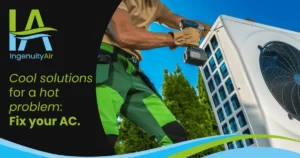
How to combat Cold and Flu Season Germs with clean air
Explore expert tips for better indoor air quality and learn about advanced air purification technologies. Breathe easier and live healthier with this guide.
Maintaining your air conditioning system is crucial. One important part of this is making sure the AC drain line does not get blocked.
A clogged AC drain line can cause several problems; these include reduced cooling efficiency, water leaks, and potential damage to your AC unit.
This guide will explain what an AC drain line is, how it works, and the most common causes of clogs. Most importantly, it will provide steps to unclog it effectively.
An AC drain line is an important part of an air conditioning system. It is responsible for draining the condensation that forms during the cooling process.
As the air conditioner cools the air, it extracts moisture, accumulating in the evaporator coil. The AC drain line allows this excess moisture to drain away from the system, preventing water buildup and potential damage.
It works on a simple principle of gravity. It is typically a PVC pipe connected to the evaporator coil or the drip pan beneath it.
The condensation collects and flows into the drain pan, exiting through the drain line. This directs the water away from the unit and your home.
Over time, the air conditioner drain line can become clogged due to various factors. Some of the common causes include:
Before proceeding with the unclogging process, confirming whether a clog is an underlying issue is essential. Follow these steps to determine if your AC drain line is clogged:
Inspect the area around the air conditioner unit or its vicinity for any signs of water leaks. Check walls, floors, and ceilings for dampness, water stains, or discoloration.
Water leaks can be a sign of a clogged drain line. The excess water has nowhere to go and may start to leak into the surrounding area.
Take a look at the drain pan beneath the evaporator coil. The drain pan collects the condensation that drips down from the ring.
The drain pan could show a clear indicator of an issue with the drain line. If it is filled with water or overflowing, the drain line is not draining properly. This could mean that the pipe is clogged.
Inspect the area around the air conditioner for any visible signs of water damage. Check nearby walls, floors, and ceilings for water stains, peeling paint or wallpaper, or soft spots.
Excessive moisture caused by a clogged drain line can lead to water damage and mold growth if left untreated.
Pay attention to how well the AC system is draining. The air conditioner should create a steady water flow from the drain line’s exit point. This exit point is usually located outside the home.
If you notice that it’s not draining correctly or there’s no water flow from the drain line, it is likely clogged.
If you’re uncertain about the presence of a clog or if the issue persists after attempting to diagnose it yourself, it’s recommended to seek the expertise of a professional HVAC technician.
They have the knowledge and tools to accurately diagnose the problem and provide the necessary solutions to resolve it effectively.
Qualified technicians like Ingenuity Air’s experts can inspect an AC system. We can identify the cause of clogs and perform the necessary repairs or cleaning. Regular maintenance and timely unclogging will also help keep your AC unit running efficiently and maintain a comfortable indoor environment. To restore proper drainage, you should identify clogs in your AC drain line. To do this, follow these steps and seek professional help if necessary.
Once you’ve confirmed a clog in the AC drain line, you have several options for unclogging. Consider the following methods:
If you have questions about unclogging your AC drain line, it is best to get help from a professional HVAC technician. If the clog persists after trying the suggested methods, it is recommended to seek professional help.
HVAC technicians have the expertise and specialized tools to accurately diagnose the issue and safely clear the drain line clog. Hiring a professional is a wise choice. They will ensure that the unclogging process is done correctly; this minimizes the risk of further damage to your AC system.
At Ingenuity Air, the trusted HVAC company, we offer professional HVAC services. Our experienced technicians can promptly diagnose and resolve these clogs, ensuring optimal system performance.
If you have persistent clogs or would like expert help, contact us. Our professional HVAC technicians are available to help. Don’t hesitate to reach out!



Explore expert tips for better indoor air quality and learn about advanced air purification technologies. Breathe easier and live healthier with this guide.

Discover the future of home heating & cooling with Trane’s variable speed products. Elevate your indoor comfort today with Ingenuity Air, your trusted HVAC partner.

Learn from our experts the causes of an air conditioner not blowing cold air. And get your home comfortable again with our step-by-step troubleshooting guide!

Ingenuity Air is a full-service mechanical services contractor serving Central Florida and beyond. Our team is dedicated to providing reliable and honest solutions for homes and businesses to stay comfortable, efficient, and worry-free.
Services:
Commercial:
IAQ Services: